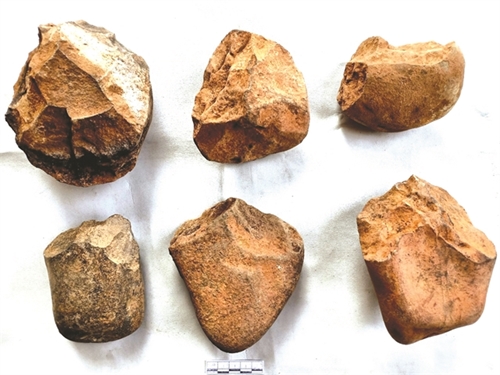The findings were announced by Associate Professor, Doctor Trinh Nang Chung from the Institute of Archaeology, Vietnam Academy of Social Sciences, on July 18.
Traces were found in Tham Kit Cave, Tham Mya Cave, Na Phoong Cave, and Ba Cua Cave in Nam Mau commune, Ba Be district.
Most traces were uncovered in Tham Kit Cave, which is 50m above the lake surface. The cave faces southwest while its inside measures nearly 3,000 square metres. Its floor is fairly smooth and divided into three large rooms with many small corners. There are many big stones inside the cave, which are believed to have fallen from the cave’s roof during big geological changes in the past.
    |
 |
|
Stone objects found inside the cave. |
Scientists discovered many carved tools from stones, and one single layer of culture of 50cm thick formed by clay inside the cave containing ancient objects, bones and teeth of animals. They also found more than 50 stone objects and traces of an oven.
The bones and teeth of animals found in the semi-fossilised form are believed to be remains of food left by early humans.
Particularly, excavators found a small flat pebble bar with two holes of some 1.2cm in diameter on the surface. The object seemed to have been carefully carved and cut; however, its usage is still a mystery.
Traces of semi-fossilised bones, teeth and stone objects showed that hunting and picking vegetables and fruits were fairly important in how early humans sought food.
Chung confirmed that based on a general examination of objects, traces and sedimentary soil, scientists believe Tham Kit Cave was a residential area of early humans in the late period of the old Stone Age, some 20,000 years ago.
Excavators have also found stone objects of Hoa Binh Civilisation (12,000-10,000 BC) in nearby Tham Mya Cave and many ceramic objects of the Metal Age in Na Phoong and Ba Cua caves.
Source: VNA